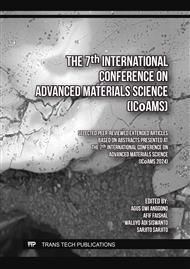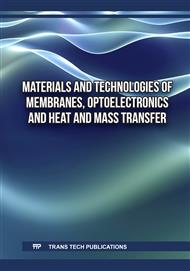[1]
K. Thoday, P. Benjamin, M. Gan, and E. Puzzolo, The Mega Conversion Program from kerosene to LPG in Indonesia: Lessons learned and recommendations for future clean cooking energy expansion, Energy Sustain. Dev., 46 (2018) 71–81.
DOI: 10.1016/j.esd.2018.05.011
Google Scholar
[2]
D. Champier, J. P. Bedecarrats, M. Rivaletto, and F. Strub, Thermoelectric power generation from biomass cook stoves, Energy, 35 2 (2010) 935–942.
DOI: 10.1016/j.energy.2009.07.015
Google Scholar
[3]
M.C. Barma, M. Riaz, R. Saidur, and B. D. Long, Estimation of thermoelectric power generation by recovering waste heat from Biomass fired thermal oil heater, Energy Convers. Manag., 98 (2015) 303–313.
DOI: 10.1016/j.enconman.2015.03.103
Google Scholar
[4]
T.W. B. Riyadi, B.R. Utomo, M. Effendy, A.T. Wijayanta, and H.H. Al-Kayiem, Effect of thermal cycling with various heating rates on the performance of thermoelectric modules, Int. J. Therm. Sci., 178 (2022) 107601.
DOI: 10.1016/j.ijthermalsci.2022.107601
Google Scholar
[5]
N.A. Nugraha, D.C. Baskoro, T.W.B. Riyadi, and A.T. Wijayanta, Thermal characteristics of thermoelectric generator at various heating rates: Experimental and numerical assessments, Therm. Sci. Eng. Prog., 52 April (2024) 102671.
DOI: 10.1016/j.tsep.2024.102671
Google Scholar
[6]
B. Orr and A. Akbarzadeh, Prospects of Waste Heat Recovery and Power Generation Using Thermoelectric Generators, Energy Procedia, 110 December (2017) 250–255.
DOI: 10.1016/j.egypro.2017.03.135
Google Scholar
[7]
B. R. Utomo, A. Sulistyanto, T. W. B. Riyadi, and A. T. Wijayanta, Enhanced Performance of Combined Photovoltaic–Thermoelectric Generator and Heat Sink Panels with a Dual-Axis Tracking System, Energies, 16 6 (2023) 1–25.
DOI: 10.3390/en16062658
Google Scholar
[8]
R. Muhammad, W.T. Ardhana, and T.W.B. Riyadi, The Role of Thermoelectric Materials in Improving the Performance of a Hybrid Solar Cell System, Adv. Sci. Technol., 141 (2024) 119–124.
DOI: 10.4028/p-cebeu2
Google Scholar
[9]
T.W. B. Riyadi, A.I. Soumi, and A. Hendrawan, Performance Assessment of a Photovoltaic Cell Coupled with a Thermoelectric Generator, Eng. Proc., 63 23 (2024) 1-7.
DOI: 10.3390/engproc2024063023
Google Scholar
[10]
T.W. B. Riyadi, M. Effendy, B. Radiant Utomo, and A. Tri Wijayanta, Performance of a photovoltaic-thermoelectric generator panel in combination with various solar tracking systems, Appl. Therm. Eng., 235 August (2023) 121336.
DOI: 10.1016/j.applthermaleng.2023.121336
Google Scholar
[11]
N. T. Atmoko, T. W. B. Riyadi, B. R. Utomo, A. Jamaldi, and A. S. Nugroho, Heat Transfer Analysis and Performance Investigation of Generator Thermoelectric Applied in LPG Stove Waste Heat Recovery, Int. J. Renew. Energy Res., 13 1 (2023) 70–76.
DOI: 10.20508/ijrer.v13i1.13137.g8696
Google Scholar
[12]
N.T. Atmoko, I. Veza, and T. W. B. Riyadi, Study On The Energy Conversion In The Thermoelectric Liquefied Petroleum Gas Cooking Stove With Different Cooling Methods, Int. J. Eng. Trends Technol., 69 1 (2021) 185–193.
DOI: 10.14445/22315381/ijett-v69i1p228
Google Scholar
[13]
N. T. Atmoko, T. W. B. Riyadi, Haikal, Amarulloh, and H. L. Wijayanto, The Experimental Investigation of Heating Rate Variant Method to Produce Power Output Generated by Thermoelectric Generator SP1848-SA, J. Phys. Conf. Ser., 1 (2022) 2406.
DOI: 10.1088/1742-6596/2406/1/012008
Google Scholar
[14]
P.P. Gohil and S. A. Channiwala, Experimental Investigation of Performance of Conventional LPG Cooking Stove, Fundam. J. Therm. Sci. Eng., 1 1 (2011) 25–34.
Google Scholar
[15]
C. Lertsatitthanakorn, P. Bamroongkhan, K. Sathapornprasath, Experimental Performance and Economic Evaluation of a Thermoelectric Liquefied Petroleum Gas (TE-LPG) Cook Stove, Int. J. Heat Technol., 37 2 (2019) 575–582.
DOI: 10.18280/ijht.370227
Google Scholar



